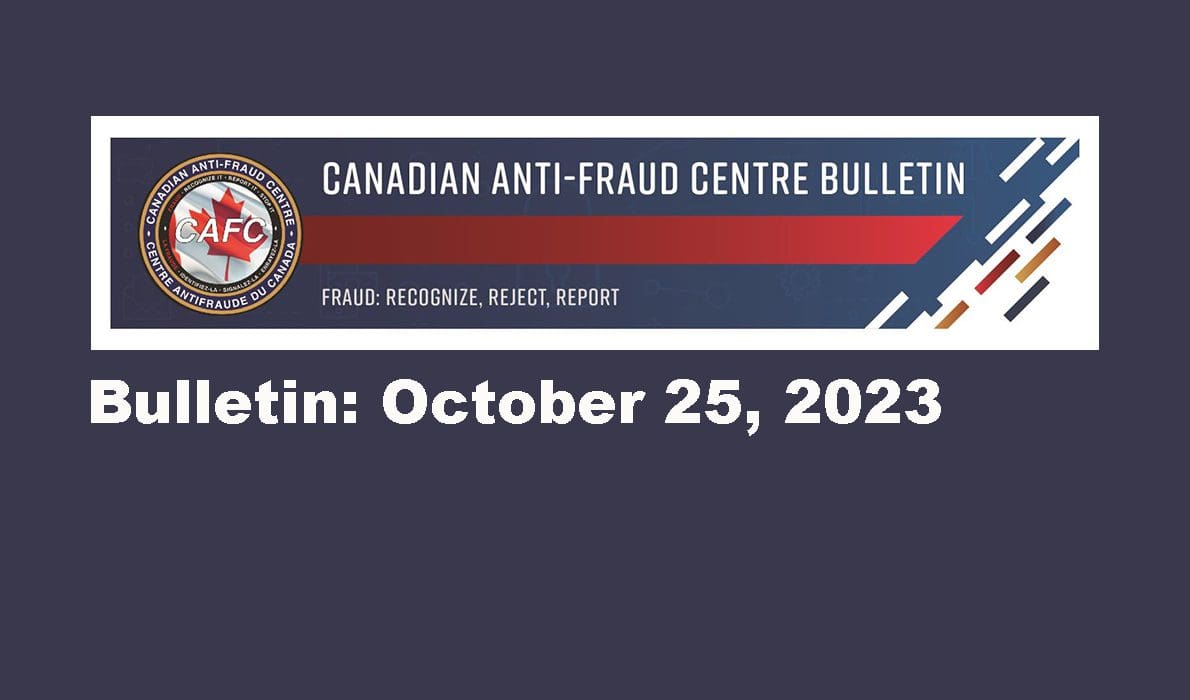BUYING AND SELLING ONLINE
This bulletin was prepared to inform the public as a part of the Canadian Anti-Fraud Centre’s (CAFC) campaign for this October’s Cyber Month.
In 2022, frauds associated to buying or selling goods or services online accounted for more than $13.3 million in reported losses. This bulletin will provide guidance on what to watch for before making a purchase or selling items online.
CAREFUL! Fraudsters are posting concert or event tickets for sale on social media or classified websites. The tickets posted are normally for events which are in high demand, but have sold out. Fraudsters are trying to capitalize on the supply shortage and the buyer’s vulnerability and will ask for a payment immediately to avoid missing the “only opportunity” to purchase tickets.
CAREFUL! Fraudsters are creating classified ads for property rentals that are available in ideal locations. The ads are posted with below average prices to attract more consumers. Interested consumers will receive prompt responses with photos stolen from legitimate ads. To secure the rental, fraudsters will ask that a payment is made quickly.
Counterfeit Merchandise
Canadians shopping online need to be on the lookout for deals that can be too good to be true. The CAFC continues to get reports of Canadians buying merchandise online that turn out to be counterfeit. Websites and advertising of counterfeit goods are often made to mimic legitimate sites, and will use tactics such as “Today Only” or “Limited Time Offer” to justify the drastic discounts. Traffic to these websites is generated by paid advertisements often displayed on various sites – including social media (Facebook, Instagram et al).
It is also important to point out that counterfeit goods are often inferior in quality and can pose significant health risks. Consumers are urged to destroy the product or deny delivery if product has not been received. By doing so, the seller subsequently loses the cost of the product and is unable to re-victimize others.
Selling Online
Similarly, beware of fraudsters looking to buy goods or services that you are selling online. Fraudsters will contact sellers via email, text or social media with a generic message wanting to buy an item without seeing it. They will claim to be out-of-town and will offer to pay above the asking price to cover the cost of shipping. The seller will either receive a fraudulent payment in the form of a counterfeit cheque, compromised credit card, or a fake email notification stating that the payment is pending. The email message says that the money will only be transferred once a tracking number is provided by the seller.
Buying and Selling Online 2
The seller will then ship the product and provide the tracking number to the fraudster. Shortly after, the seller will realize that the payment notification was fake and that no money is available.
CAREFUL! If you are selling a vehicle online, fraudsters may ask for a “VIN report” which provides an accident history of your vehicle. Fraudsters will send a link to a website that will ask for your credit card information to access the report. Once you provide your credit card information, your card can be used for fraudulent purchases or transactions.
CAREFUL! Fraudsters may express an interest in purchasing an item you have for sale. They will claim that they are sending an etransfer to pay for the item, but in reality, it’s a request for funds from your account or could also be a phishing message asking for your banking credentials.
Buying and Selling Online – Fraud Warning Signs
- Be cautious of blowout sales or greatly reduced prices (e.g. 80%).
- Beware of rental units that are listed below fair market value.
- Notice text with spelling errors or references to the product as “the item”.
- Beware of pets being offered at below market value.
- Beware of overseas buyers who want to buy without seeing the product first.
- Beware of overpayments for items you are selling.
- Beware of high-volume purchases that need to be shipped urgently.
How to protect yourself
- Know the market value of the product you are looking for.
- Locate and verify the sellers contact information (address, phone number, email) before you buy.
- Look for customer reviews and ratings from third-party sources.
- Use a payment method with fraud protection (e.g. pay by credit card)
- Whenever possible, pick up items and provide the payment in person.
- Review all email information to make sure they are coming from a legitimate source.
- Never transfer funds (e.g. shipping company) in order to receive a payment for an item you’re selling.
- Do your research and use reputable websites to purchase VIN reports.
- Do an online search to see if anyone has already reported the fraudulent buyer or seller.
Want to learn more?
CLICK HERE to Learn more tips and tricks for protecting yourself.
HOW TO REPORT A SCAM OR FRAUD
Anyone who suspects they have been the victim of cybercrime or fraud should:
- Report it to their local police and
- Report it to the Canadian Anti-Fraud Centre’s – CLICK HERE to report online
- Call the CAFC toll free number at 1-888-495-8501.


